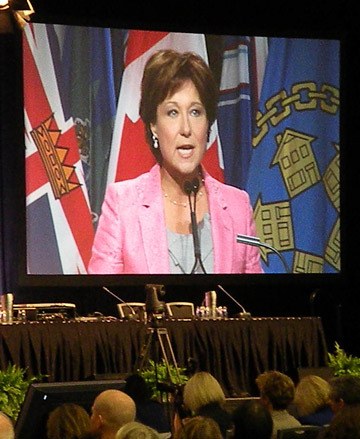VANCOUVER – Premier Christy Clark used her speech to the local government convention Friday to persuade delegates that her government’s liquefied natural gas export plan is becoming reality, and communities will share in the proceeds.
Clark said the consortium of Chevron and Apache Corp. has already spent $800 million on site preparations for its proposal to pipe gas from northeast B.C. shale formations to the North Coast.
“They have literally moved a mountain,” Clark said. “They have 500 people working on this project her in British Columbia, and they’re just one company.”
Another indication came from her meeting with the council from tiny Port Edward, which had no municipal land sales for 12 years. So far this year $2 million has been paid to purchase land, with another $2 million expected by the end of 2013, she said.
None of the half dozen international bidders for LNG projects has reached a final decision on financing, but the first ones are expected by next year. That puts B.C. ahead of any U.S. plan to export its abundant shale gas, Clark said after her speech.
Communities such as Kitimat, the main port, and Fort Nelson, centre of gas production and processing, are already feeling the pressures of intense industrial development. Convention workshops discussed the problem of “shadow populations,” mainly hundreds of remote work camps that set up outside municipal borders but still use airports, garbage dumps and other services.
Northern communities get no taxes and little commercial benefit from the camps, and workers fly in and out without ever visiting the communities. Some mayors said their trip to Vancouver and back for the Union of B.C. Municipalities convention was made more difficult because flights are booked up by construction and gas workers.
Clark announced a new “LNG-Buy B.C.” program intended to connect multinational companies such as Shell and Korea Gas with local suppliers.
She also gave Forests, Lands and Natural Resources Minister Steve Thomson a new job, responsible for rural development and reversing decades of falling population in rural communities.
